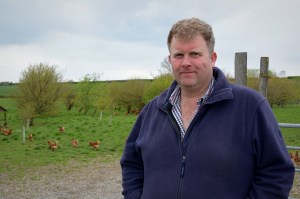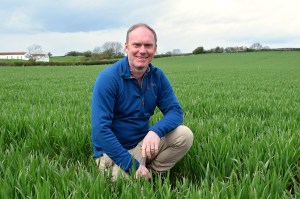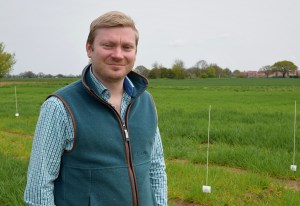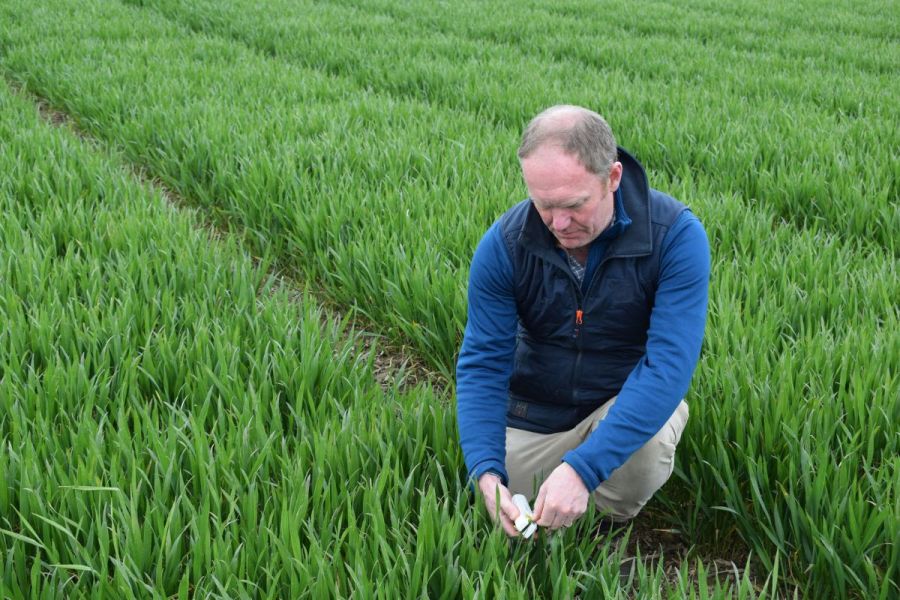Could a two-pronged approach to NUE help to reduce reliance on traditional N and mitigate risk? CPM visits a mixed farm in Darlington to find out more.
“It’s very easy to continue with the simple options, but you have to be brave and push yourself to do more.”
By Janine Adamson
Ask any farmer what they’re most concerned about, and they’ll undoubtedly discuss input costs and availability. And for crop-essential nutrients such as nitrogen, the past few years have shown even a Magic 8 Ball couldn’t predict what lies ahead.
According to William Maughan of Denton Grange West, a 200ha mixed system in Darlington, this means a focus on financial risk management. “Each year is different, you’ve no idea what the season will do, which has a huge impact on N use.

William Maughan’s farm strategy is hinged on ‘muck management’ and how to make the most of what’s already available.
“At the same time, prices are volatile, labour is stretched and we’re under increasing pressure to reduce our carbon footprint. It’s essential we find new ways to be more efficient and manage risk because the job of farming is becoming much harder.”
Due to juggling a mixed system of 30,000 free-range hens, 200 beef cattle and a cereal-based cropping rotation, William says his approach has had to evolve. For him, it’s centred around ‘muck management’ and how to make the most of what’s already available, while applying principles similar to those of regenerative systems.
This includes gradually reducing his use of the plough, planting both cover and companion crops, and working to extend the rotation by an additional two years. Now, his focus is on realising the full potential of the animal waste he has available.
“I think all farmers are having to rethink nutrient use, mainly due to prices. However, for us, having recently increased our hen numbers we have a lot of poultry manure to supplement conventional N. Although that’s a bonus, it’s also incredibly important we do it in a sustainable way that mitigates pollution risk.”
His aim to operate in a conscious manner is what led William to work more closely with his agronomist Nigel Scott from ProCam. Together they’re navigating the world of nitrogen use efficiency (NUE) which has resulted in the farm hosting replicated field trials exploring the topic.

A step change among growers means more time is being spent tailoring nutrition plans, says Nigel Scott.
Nigel says he’s seen a recent step-change among other growers in the North East. “This is a traditional cropping area, but even the farmers you’d least expect are making positive changes. I’m spending an increasing amount of my time tailoring nutrition plans.”
The ProCam trials at Denton Grange West focus on two elements of NUE in wheat – optimisation of what’s being applied through plant uptake and identifying alternative sources. The protocol involves investigating how three ‘alternative N’ products respond within different N regimes, based on the farm standard of 180kgN/ha (100%) and two levels of reduced input. This is combined with a range of biostimulant technologies that aim to improve nitrogen assimilation in the plant.
ProCam’s technical development manager, Rob Adamson, says the goal is to provide clear guidance on options available to growers who want to reduce their reliance on synthetic N while optimising profitability.
“There are various reasons why growers might turn away from traditional sources of N, including margin over input costs, a drive towards regenerative practices, efforts to reduce carbon emissions, or the pinch of supply constraints. Along with existing ways to boost the NUE of what’s applied, new technologies are in the pipeline,” he says.
“We want to understand how these technologies work as stand-alone treatments as well as in a programme together to futureproof nitrogen management irrespective of conventional fertiliser prices.”
According to Rob, rather than replacing synthetic nitrogen completely, understanding how innovative products complement existing regimes, both standard and reduced input, will provide valuable insight. For those applying full nitrogen rates, he believes this could be a way of pushing yield even further.
The three ‘alternative N’ products in the wheat trial are the endophyte product Encera, plant growth promoting rhizobacter SR3, and polymer urea N-viron 28.
Encera contains a species of bacteria that metabolises atmospheric nitrogen into forms available to crops. The bacteria live within the cells of plants, rather than the spaces between them or on plant surfaces.

Rob Adamson says the goal is to provide clear guidance on options for those who want to reduce their reliance on synthetic N while optimising profitability.
In contrast, SR3 from Plantworks is a plant growth promoting rhizobacteria (PGPR) which lives in the soil. It has the ability to fix atmospheric nitrogen while unlocking soil-bound phosphorus and potassium. Finally, N-viron28 slowly releases nitrogen over a six-week period due to its formulation.
Application timings are dictated by each product’s mode of action, says Rob, but it’s trial results which he thinks will catch attention. “Initial trials hosted at ProCam Cawood demonstrated a 7.5% yield increase compared with the control as a result of Encera being applied at T1. This equates to £114/ha (0.57t x £200/t), which is significant.”
According to Rob, a key indicator of the product’s success was greening of the canopy, which was improved from leaf 3 up to the flag leaf. He credits this to the improved N assimilation in the plant cells.
By rolling out on-farm trials, it’s hoped to improve understanding around how each product performs in isolation, as well as the potential of stacked benefits across the whole programme. For the varying N regimes, the first application is a consistent 60kgN/ha, which ProCam says is critical for tiller survival, with subsequent doses being reduced by 25% or 50%.
To complete the treatment list, a range of biostimulant products is also being tested, applied both alone and in combination with N-viron28 at T1 and T2. These products, such as Unium’s Twoxo, address the ‘maximising plant uptake and utilisation’ aspect of the trial.
Although admittedly an intricate set-up, William says it’s fulfilling to host a trial of this complexity. “It’s very satisfying seeing this here within our own farming scenario. I hope we can start to use some of the products, to find our sweet spot.
“In the past it’s been difficult – regular soil testing has shown nutrient levels are highly variable due to the hen muck we apply, so we’ve struggled to get it right. Therefore having a range of flexible options is critical. Hopefully this’ll provide the answers we require on a per season basis, whether that’s this year or next,” he says.
Given William feeds home-grown grain to his beef cattle, a reduction in conventional fertiliser use could have a positive impact on the carbon footprint of the farm’s livestock production business. He’s also trying innovative feed additives that aim to reduce emissions from poultry manure.
“I want a greater understanding of our environmental impact from a whole-farm perspective,” he says. “It’s only a matter of time before it becomes a requirement, so it’d be great to be a step ahead through using crop inputs with a lower carbon footprint.”
Driving this move towards sustainable practices is something William’s proud of, and a message he shares through his local benchmarking group.
“It’s very easy to continue with the simple options, but you have to be brave and push yourself to do more. I’m hosting an open day for our benchmarking group, as well as the local NFU, to share the positive results we’re achieving,” he says.
Nigel believes the farm’s success is due to William leading the change, rather than Nigel forcing it as an agronomist. Instead, Nigel prefers to operate in close alignment to the classical definition of agronomy – advising on the science of crop production. “Good crop management is beyond the visual – a simple weed or disease.
“It’s tapping into what we already have in the soil, understanding the mechanics of plant biology and giving the crop its best chance to use what’s available. We have to think beyond what’s in the shed and guide growers through what often proves to be a complicated area.”
Nigel stresses that exploring alternative nitrogen sources shouldn’t distract from what’s been learnt the past few years in terms of biostimulant use. This, he says, is the whole purpose of the two-pronged approach ProCam hopes to validify.
“It’s easy to switch focus and become engrossed by the next hot topic when, really, the two are serving very different but complimentary purposes,” he concludes.
This article was taken from the latest issue of CPM. For more articles like this, subscribe here.
Sign up for Crop Production Magazine’s FREE e-newsletter here.




